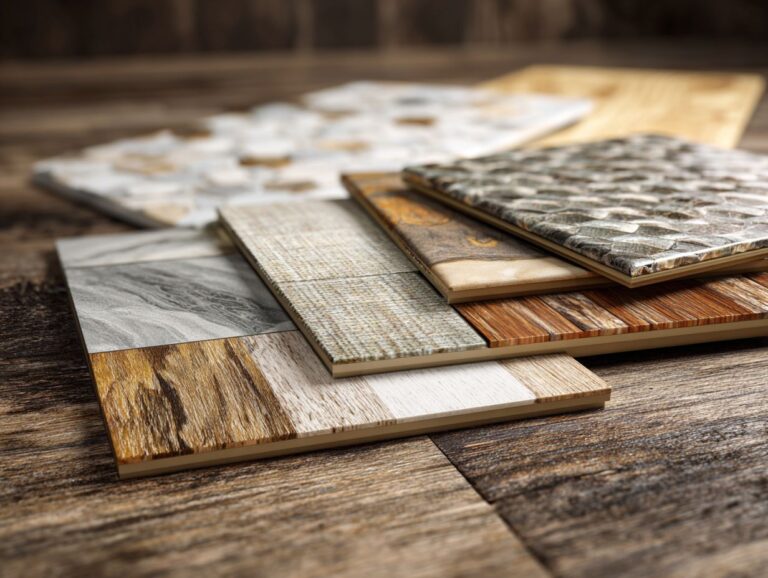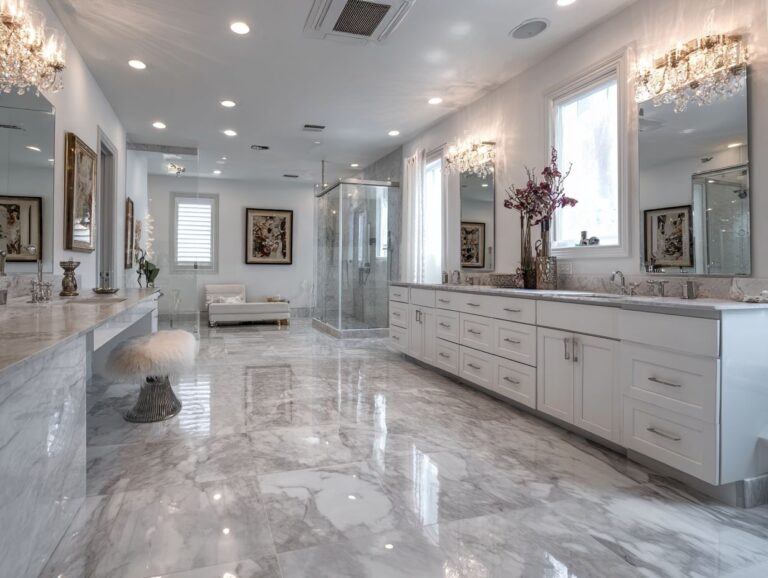Sheet Vinyl vs Vinyl Plank vs Vinyl Tile Comparison
Selecting the right vinyl flooring can be confusing. With options like vinyl plank, vinyl sheet, and vinyl tile available, it’s essential to understand their unique characteristics. In this detailed comparison, we’ll look at the advantages of these sturdy flooring choices, assisting you in choosing the right option for your area. Find out which vinyl flooring option matches your preferences and style!
Key Takeaways:
Contents
- Vinyl Flooring Market Data 2024
- Sheet Vinyl
- Vinyl Plank Flooring
- Vinyl Tile Flooring
- Comparison of Sheet Vinyl, Vinyl Plank, and Vinyl Tile
- Frequently Asked Questions
- What is the difference between sheet vinyl, vinyl plank, and vinyl tile?
- What are the benefits of sheet vinyl?
- What are the benefits of vinyl plank and tile?
- Which is more durable, sheet vinyl or vinyl plank/tile?
- What is the installation process like for each type of vinyl flooring?
- How do I determine which type of vinyl flooring is best for my space?
Overview of Vinyl Flooring Types
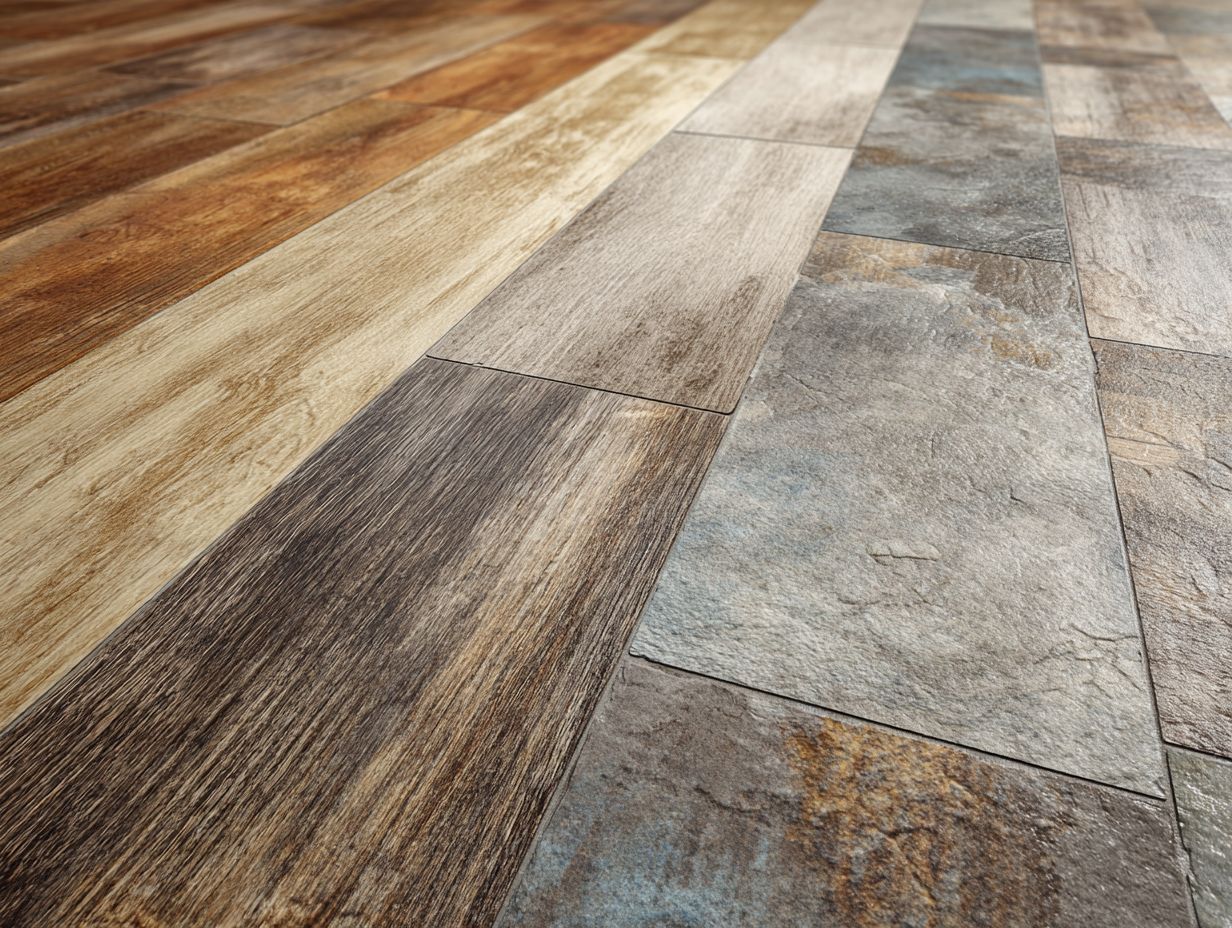
Vinyl flooring is available in three main types: sheet vinyl, vinyl plank, and vinyl tile, each offering unique features that suit different needs and preferences.
Sheet vinyl is a cost-effective solution for large areas like kitchens and bathrooms, providing a seamless, moisture-resistant surface.
Vinyl plank mimics hardwood with its realistic texture and is perfect for living rooms and hallways, where style and durability are essential.
Vinyl tile is a good choice for entryways and laundry rooms because it allows you to create attractive patterns and is easy to clean.
Each type caters to specific home settings, balancing practicality and aesthetic appeal.
Vinyl Flooring Market Data 2024
Vinyl Flooring Market Data 2024
For those considering flooring options, it’s important to weigh the benefits of different materials. A commonly debated topic is the choice between Luxury Vinyl Plank and Luxury Vinyl Tile. A related guide provides detailed insights into their differences and can help in making an informed decision.
Market Overview: Market Size and Growth
Market Overview: Regional Insights
Market Overview: Segment Analysis
The Vinyl Flooring Market Data 2024 gives a detailed overview of the market’s current size, expected growth, regional information, and segment breakdown, showing important trends and possible chances in the industry.
Market Overview shows a changing market, with the market size expected to increase from $36.63 billion in 2023 to $66.94 billion by 2032. This growth, marked by a 6.8% annual growth rate Strong demand is expected between 2024 and 2032 because the product is long-lasting, looks good, and saves money.
- Regional Insights: The Asia Pacific region stands out with a market size of $12.43 billion in 2023 and a significant 43% market share in 2024. This dominance is likely due to rapid urbanization, rising disposable incomes, and increased construction activities. Meanwhile, North America is experiencing a remarkable 13.9% growth rate, indicating a strong market driven by renovations and the preference for sustainable flooring solutions.
- Segment Analysis: The data indicates that Luxury Vinyl Tiles (LVT) will capture a substantial 65% market share in 2024. LVT’s popularity is attributed to its high-end aesthetics and versatility. In contrast, Vinyl Sheets are expected to grow at a 3.35% rate, showing steady demand. Additionally, the commercial application segment is projected to hold a 54.34% market share in 2024, reflecting the product’s suitability for high-traffic areas and its adoption in commercial projects due to its durability and design variety.
Overall, the Vinyl Flooring Market Data 2024 highlights promising growth prospects, particularly in the Asia Pacific and North American regions, alongside a strong preference for luxury vinyl tiles. The market is growing because of new product ideas and a move towards eco-friendly building materials, which makes it appealing to both investors and manufacturers.
Importance of Choosing the Right Type
Selecting the right type of vinyl flooring can significantly influence the durability, maintenance, and overall aesthetic of your space, impacting long-term satisfaction.
Consider factors like durability in high-traffic areas, where thicker, multi-layer vinyl options usually show greater resilience.
If maintenance is a priority, choose vinyl with a protective wear layer; simpler cleaning routines can save you time and effort.
Cost is another key aspect: while luxury vinyl tiles may offer higher quality, modular plank options can be budget-friendly without skimping on style (for a detailed comparison, see our guide on Luxury Vinyl Plank vs Luxury Vinyl Tile).
Assess your lifestyle-families with pets often find scratch-resistant finishes beneficial, while minimalistic tastes might lean towards seamless designs.
Sheet Vinyl
Sheet vinyl is one piece of flooring that has a smooth look, making it a good choice for wet areas like bathrooms and kitchens. For those interested in exploring different types of vinyl flooring, such as luxury vinyl plank and tile, our comprehensive guide offers a deep dive into these options.
Definition and Composition
Sheet vinyl is usually made with a mix of polyvinyl chloride (PVC) and other materials, providing strong and bendable flooring that works well in busy areas.
This sheet vinyl material does not let water through, so it’s a good choice for kitchens and bathrooms.
Its durability is increased by its ability to resist scratches and stains, keeping it looking good for a long time. The flexibility of sheet vinyl allows it to conform to uneven subfloors, minimizing the chance of damage or wear.
For installation, use a vinyl flooring adhesive for better adherence, and consider underlayment options to improve comfort underfoot and sound insulation.
Regular cleaning with a damp mop will keep it looking new for years.
Installation Process
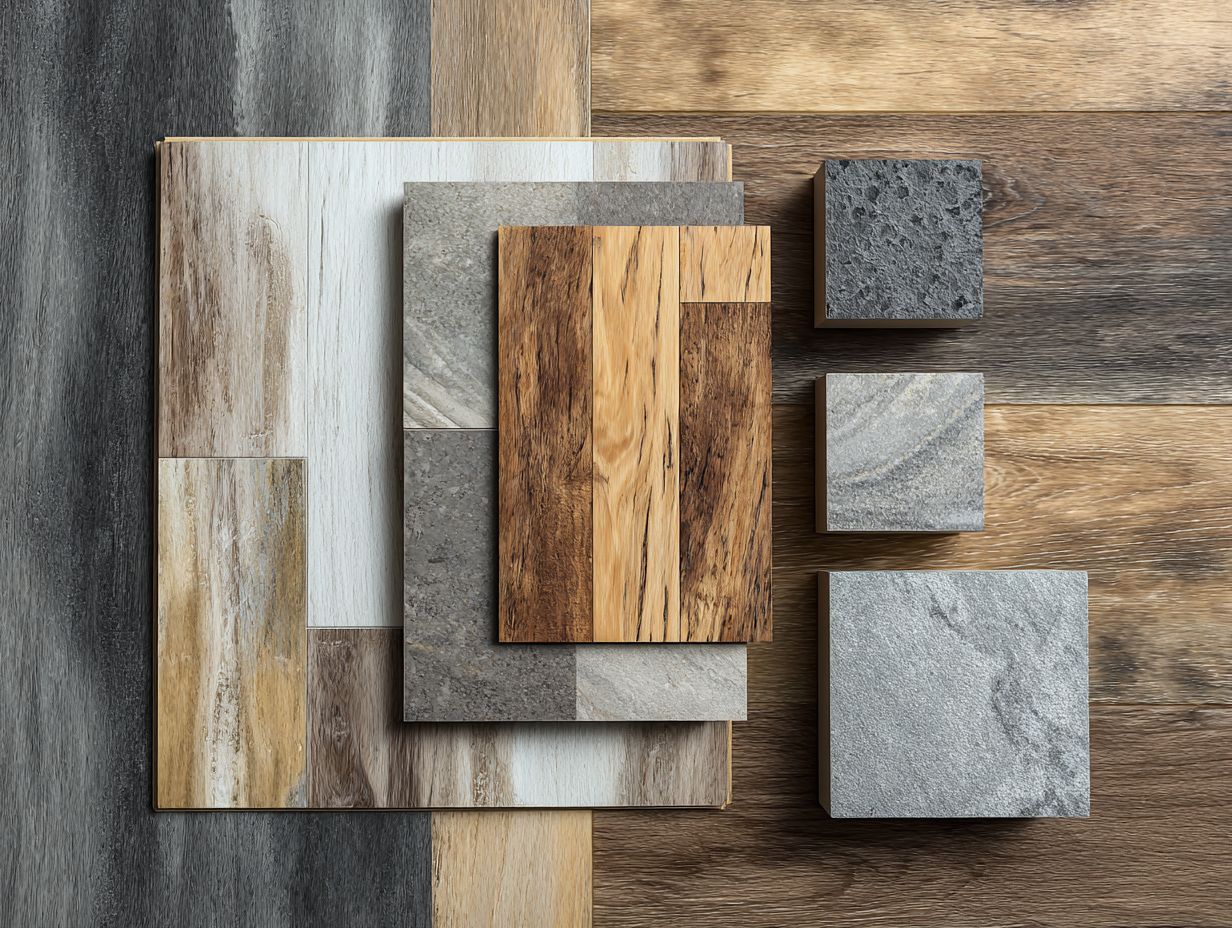
Installing sheet vinyl typically involves preparing the subfloor, applying adhesive, and rolling out the vinyl in a continuous sheet to avoid seams.
- Begin by ensuring the subfloor is clean, dry, and level; use a utility knife to trim any high spots.
- Next, gather the needed items such as a small shovel for applying glue, a roller for smoothing surfaces, and a ruler for cutting edges precisely.
- When applying the adhesive, follow the manufacturer’s instructions on curing time.
- To install, roll out the vinyl, allowing it to lay flat, and use the roller to press it down firmly.
- For a smooth result, hiring a flooring expert can save time and make sure the installation is done correctly.
Durability and Maintenance
Sheet vinyl boasts impressive durability, often coming with scratch-resistant coatings that make it easy to maintain with simple cleaning routines.
To keep sheet vinyl looking its best, regular cleaning is essential. Use a broom or vacuum to remove dirt and debris, then mop with a mixture of warm water and a few drops of mild dish soap.
For tougher stains, a solution of vinegar and water can effectively lift spots without damaging the surface. Avoid harsh chemicals, as they can compromise the protective layer.
With proper care, sheet vinyl can resist scratches, stains, and fading, ensuring it remains an attractive flooring choice for years.
Cost Analysis
The price of sheet vinyl usually falls between $0.50 and $3.00 for each square foot, which makes it an affordable flooring option for many people.
When calculating total expenses, consider installation fees which can add $1.00 to $2.50 per square foot, depending on your location and contractor choice.
Factor in long-term savings; sheet vinyl is low-maintenance and resistant to stains and water, potentially reducing repair costs over time.
For example, if you install 500 square feet at $2.00 per square foot, the material cost is $1,000, with an estimated $1,250 for installation. You may spend around $2,250 upfront, but enjoy significant savings in maintenance for years to come.
Design Options
Sheet vinyl comes in many designs, including wood and stone styles, as well as bright colors and patterns that improve the appearance of any room.
For instance, luxury vinyl planks mimic the warmth of hardwood, perfect for living rooms, while tile-look vinyl works well in kitchens and bathrooms due to its water resistance.
Brands like Armstrong and Karndean offer collections that fit various styles, from rustic to modern. To integrate these designs seamlessly, consider your existing decor: a contemporary kitchen might benefit from sleek, dark stone patterns, while a cozy den could feature lighter, wood-inspired vinyl to create an inviting atmosphere.
Vinyl Plank Flooring
Vinyl plank flooring looks like hardwood, giving a cozy appearance and also providing the strength and waterproof features of man-made materials.
Definition and Composition
Vinyl plank flooring is constructed from multiple layers, including a wear layer, design layer, and core, ensuring longevity and performance in high-traffic areas.
The top layer, generally 20 to 30 mil thick, protects against scratches and stains, making it ideal for busy homes.
Directly beneath, the design layer displays vivid visuals and textures, mimicking natural wood or stone. The main layer gives support and strength; choices like solid polymer or composite material increase toughness and protect against moisture.
These layers work together to give an appealing appearance and make the flooring durable, allowing it to withstand daily wear. This combination makes vinyl plank an excellent choice for kitchens, living rooms, and even bathrooms.
Installation Process
You can install vinyl plank flooring in different ways, such as click-lock installation, which doesn’t need glue and is simple for DIY enthusiasts.
To install successfully, you’ll need some basic tools: a utility knife to cut the planks, a tapping block to make sure the seams fit snugly, and a measuring tape for laying out correctly.
When installing, doing it yourself can save money and let you make it your own. Hiring a flooring expert gives professional results and can be faster, especially for tricky designs.
Comparing the cost of about $2 per square foot for doing it yourself to roughly $5 per square foot for hiring a professional can help you decide.
Durability and Maintenance
Vinyl planks are designed to withstand heavy foot traffic and are often scratch-resistant, requiring minimal maintenance to keep them looking new.
To make your floors last, frequently sweep or vacuum to get rid of dirt and debris. From time to time, use a damp mop with a gentle cleaner for a more thorough cleaning.
If scratches occur, consider using a vinyl floor repair kit, which typically includes a color-matched putty to fill in minor imperfections.
For stubborn stains, avoid abrasive cleaners; instead, opt for a mixture of vinegar and water.
Placing mats at entryways can also reduce wear and tear, enhancing durability and maintaining the aesthetic appeal of your flooring.
Cost Analysis
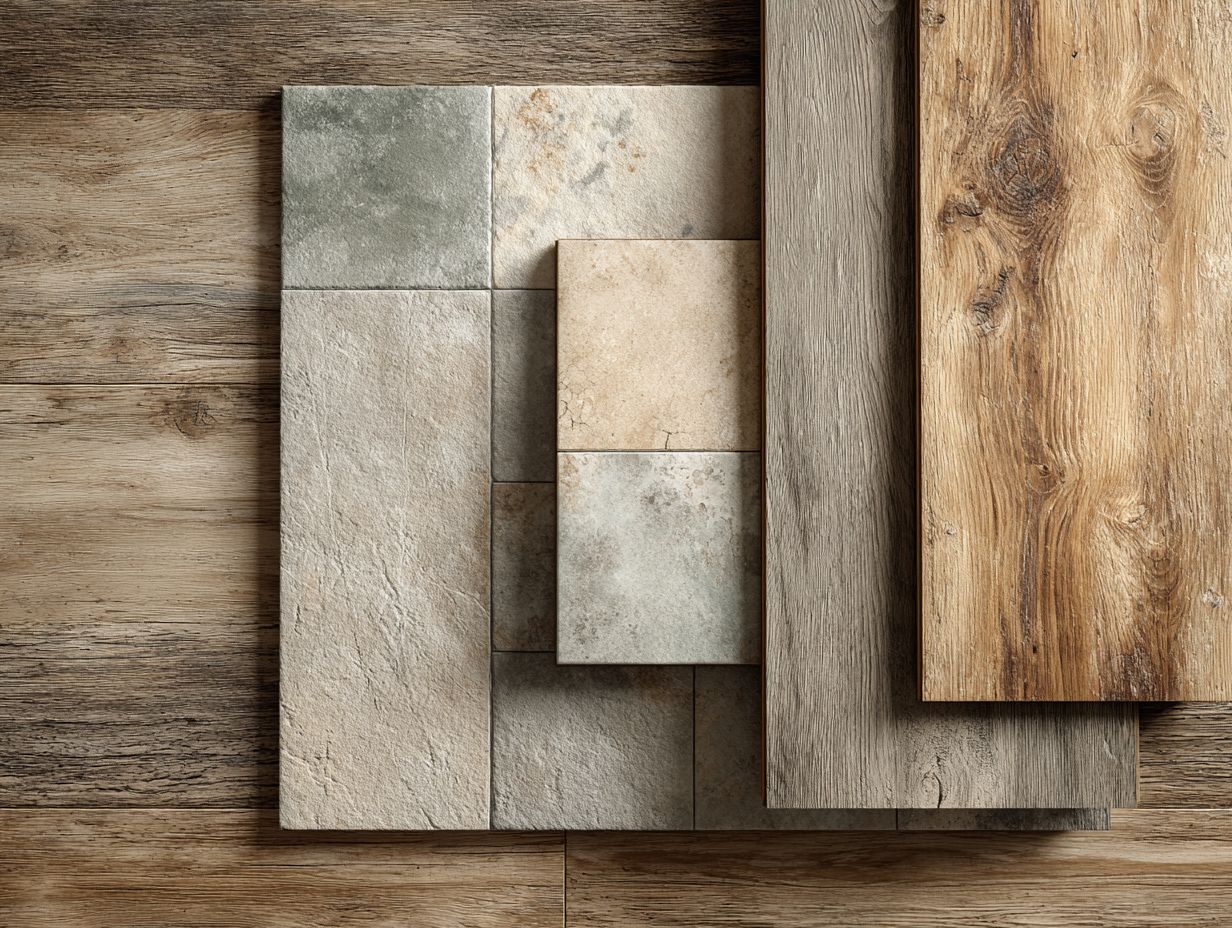
Vinyl plank flooring costs between $2 and $5 per square foot, providing a budget-friendly option compared to hardwood and looking similar.
When considering installation, budget an additional $1 to $3 per square foot. For example, if you choose a budget-friendly option like the LifeProof vinyl plank at $2.50 per square foot, the total cost for a 500 square foot room would be approximately $2,500, including mid-range installation prices.
More premium options like Mohawk’s RevWood can cost around $3.50 per square foot, totaling $3,500 with installation. Always factor in any DIY efforts to save on costs, as many homeowners can install simpler products themselves.
Design Options
Available in various finishes, vinyl plank flooring can replicate the look of natural wood grain, providing homeowners with a wide array of design choices.
Styles range from rustic oak to sleek mahogany, allowing homeowners to match their decor seamlessly. For a modern look, consider planks with a matte finish and wider dimensions for an open feel.
If your interior leans towards traditional, opt for textured finishes that mimic reclaimed wood. Brands like Shaw and Mohawk offer various colors and styles, ensuring you can find the perfect fit for kitchens, living rooms, or even bathrooms.
Always check for water resistance and easy maintenance options, especially in high-traffic areas.
Vinyl Tile Flooring
Vinyl tile flooring consists of individual tiles, which is easy to repair and fit in various parts of the house.
Definition and Composition
Vinyl tile is constructed from similar materials as other vinyl options, combining durability with design flexibility while often being eco-friendly.
Vinyl tiles, usually made from polyvinyl chloride (PVC), have a backing that makes them more durable and comfortable. To be eco-friendly, many manufacturers use recycled materials and low-VOC adhesives to reduce indoor air pollution.
Brands like Shaw and Armstrong focus on sustainable practices, utilizing manufacturing processes that conserve energy and water. Think about picking products approved by groups like GreenGuard. They test materials to meet strict standards for chemical emissions, helping to create healthier indoor spaces.
Installation Process
Putting down vinyl tile flooring can be simple, often using tiles that snap together or have sticky backing to stay in place.
First, collect these necessary tools:
- a vinyl tile cutter or a utility knife
- a straight edge
- a measuring tape
- a roller to make sure the tiles stick tightly
Begin by preparing the subfloor; it should be clean, dry, and even. Measure the room to determine how many tiles you’ll need, and plan for cuts along the edges.
Lay tiles from the center outwards for a balanced look, and use adhesive carefully if required. After installing, press down on the tiles to hold them in place, giving the room a neat and appealing look.
Durability and Maintenance
Vinyl tile flooring is durable and resistant to damage, making it a suitable option for busy households. It is simple to maintain its appearance with routine cleaning.
- To keep vinyl tile flooring looking new, focus on regular sweeping or vacuuming to remove dirt and debris.
- For deeper cleaning, use a damp mop with a mixture of warm water and a few drops of mild dish soap. Avoid harsh chemical cleaners, as they can dull the surface.
- Think about using a vinyl floor polish twice a year to keep it shiny and prevent scratches.
- Place mats at entryways to minimize dirt that may scratch the tiles, ensuring they last even longer.
Cost Analysis
Vinyl tile flooring costs between $1 and $4 per square foot. The price varies with style and thickness, fitting different budgets.
When considering long-term savings, vinyl flooring can significantly reduce maintenance costs compared to hardwood or carpet.
For example, hardwood might need refinishing from time to time, costing $1.50 to $5 per square foot. On the other hand, vinyl generally needs mopping occasionally and a simple refresh every few years, which can save you a lot of money.
It offers excellent durability, with many products lasting over 20 years, thus minimizing replacement expenses.
Vinyl flooring might cost less at first compared to other types, but it saves money over time because it’s cheaper to maintain.
Design Options
With a multitude of colors, patterns, and textures available, vinyl tile flooring caters to diverse aesthetic preferences and design schemes.
For example, sleek, monochromatic tiles work beautifully in modern minimalist homes, creating a sophisticated look. Conversely, wood-look vinyl tiles can warm up a traditional space, adding rustic charm without the upkeep of hardwood.
Tiles with patterns, such as geometric designs, add character to kitchens or bathrooms, turning them into main attractions. By picking the right vinyl tile, homeowners can change any room to show their personal taste while enjoying long-lasting quality and simple upkeep.
Comparison of Sheet Vinyl, Vinyl Plank, and Vinyl Tile
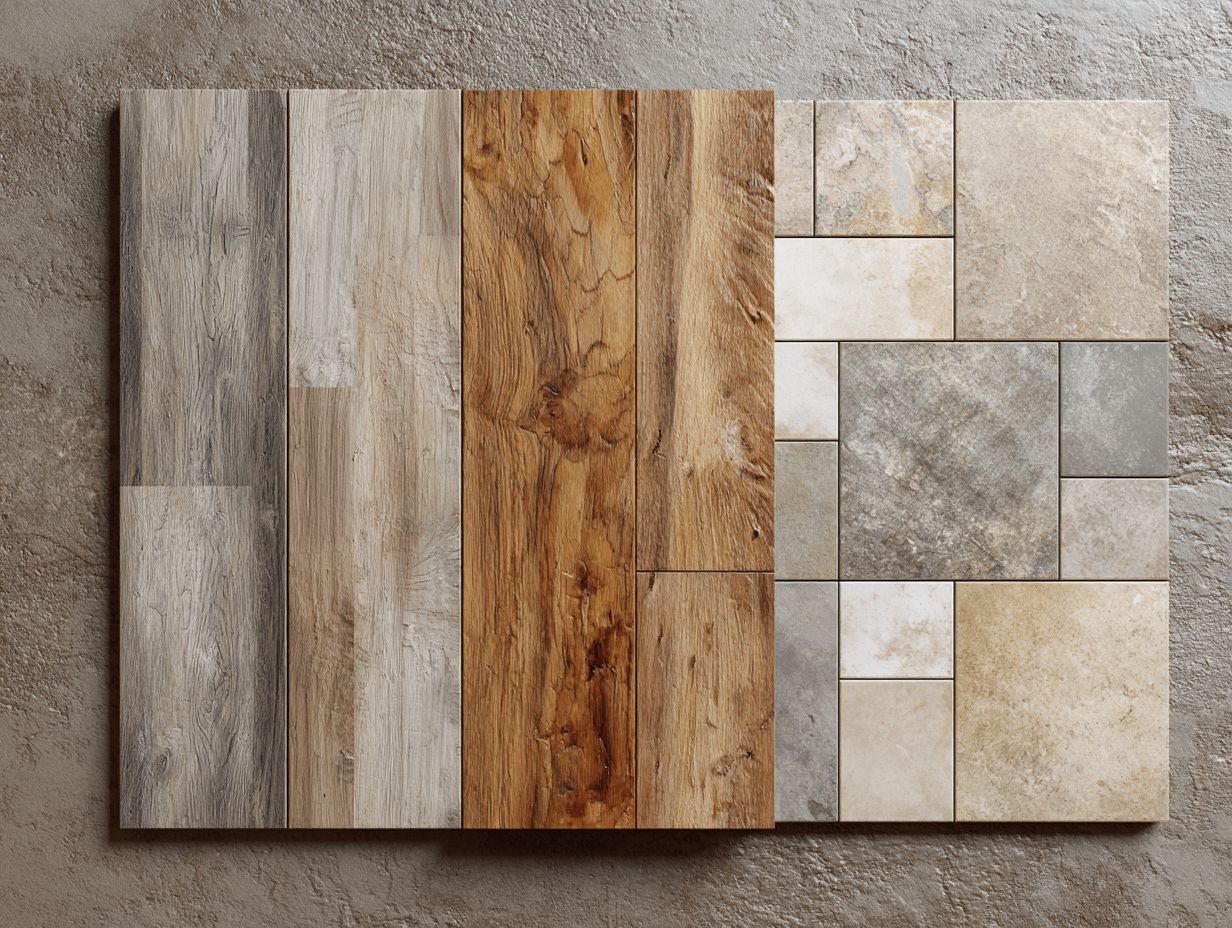
Looking at sheet vinyl, vinyl plank, and vinyl tile helps to identify their pros and cons, which affect which flooring is most suitable for different situations.
Key Differences in Composition
The composition of sheet vinyl, vinyl planks, and vinyl tiles varies significantly, impacting their durability, aesthetics, and installation methods.
Sheet vinyl is usually one large piece, which reduces the chances of seams and water damage. Conversely, vinyl planks feature a rigid, dimensional design that mimics hardwood, enhancing visual appeal while providing better durability.
Vinyl tiles, typically square-shaped, offer extensive design versatility but can be more challenging to install due to individual piece handling.
When planning your layout, use tools like the Smart Tile App to see the final appearance. Hiring professional installers can lead to a high-quality finish, especially with plank and tile options.
Performance and Longevity
In terms of performance, vinyl plank flooring typically outlasts sheet vinyl and vinyl tiles, especially in high-traffic and moisture-prone areas.
Vinyl plank flooring is designed to withstand wear and moisture due to its durable construction and protective top layer. For instance, brands like Mohawk and Shaw offer products specifically engineered for durability, often backed by warranties of 15-30 years.
In bathrooms or kitchens, choosing a 100% waterproof option like LifeProof can prevent issues from spills. Proper installation using glue or click-lock methods increases durability.
Regular maintenance, such as cleaning with mild detergents and avoiding abrasive tools, will further extend the life of your flooring.
Best Use Cases for Each Type
Choosing the right type of vinyl flooring depends on specific use cases, such as:
- Sheet vinyl for bathrooms
- Vinyl planks for living rooms
- Vinyl tiles for kitchens
For bathrooms, sheet vinyl is ideal due to its seamless design, offering moisture resistance and easy cleaning.
In living rooms, vinyl planks look like hardwood and are long-lasting, which makes them ideal for areas with a lot of foot traffic.
Kitchens benefit from vinyl tiles, which allow for creative patterns and easier repair.
To maximize longevity, consider using a waterproof underlayment, especially in moisture-prone areas.
Choosing the appropriate vinyl for each room can improve both the look and use of your home.
Frequently Asked Questions
What is the difference between sheet vinyl, vinyl plank, and vinyl tile?
Sheet vinyl is a large, continuous roll of vinyl flooring, while vinyl plank and tile come in individual pieces that mimic the look of wood or tile.
What are the benefits of sheet vinyl?
Sheet vinyl is affordable, easy to install, and provides a seamless, water-resistant surface. It is also available in a wide variety of styles and patterns.
What are the benefits of vinyl plank and tile?
Vinyl plank and tile offer a realistic appearance of wood or tile without the cost and maintenance. They are also durable and easy to replace if damaged.
Which is more durable, sheet vinyl or vinyl plank/tile?
Vinyl plank and tile tend to be more durable due to their thicker wear layers. Still, sheet vinyl may work well in areas where there isn’t much foot traffic.
What is the installation process like for each type of vinyl flooring?
Sheet vinyl often requires professional installation, while vinyl plank and tile can be installed as a DIY project. Both methods typically involve adhesive or click-lock systems.
How do I determine which type of vinyl flooring is best for my space?
Consider factors such as your budget, the level of traffic in the room, and the desired style and look. Consider speaking with a flooring specialist to get advice specific to your situation.
